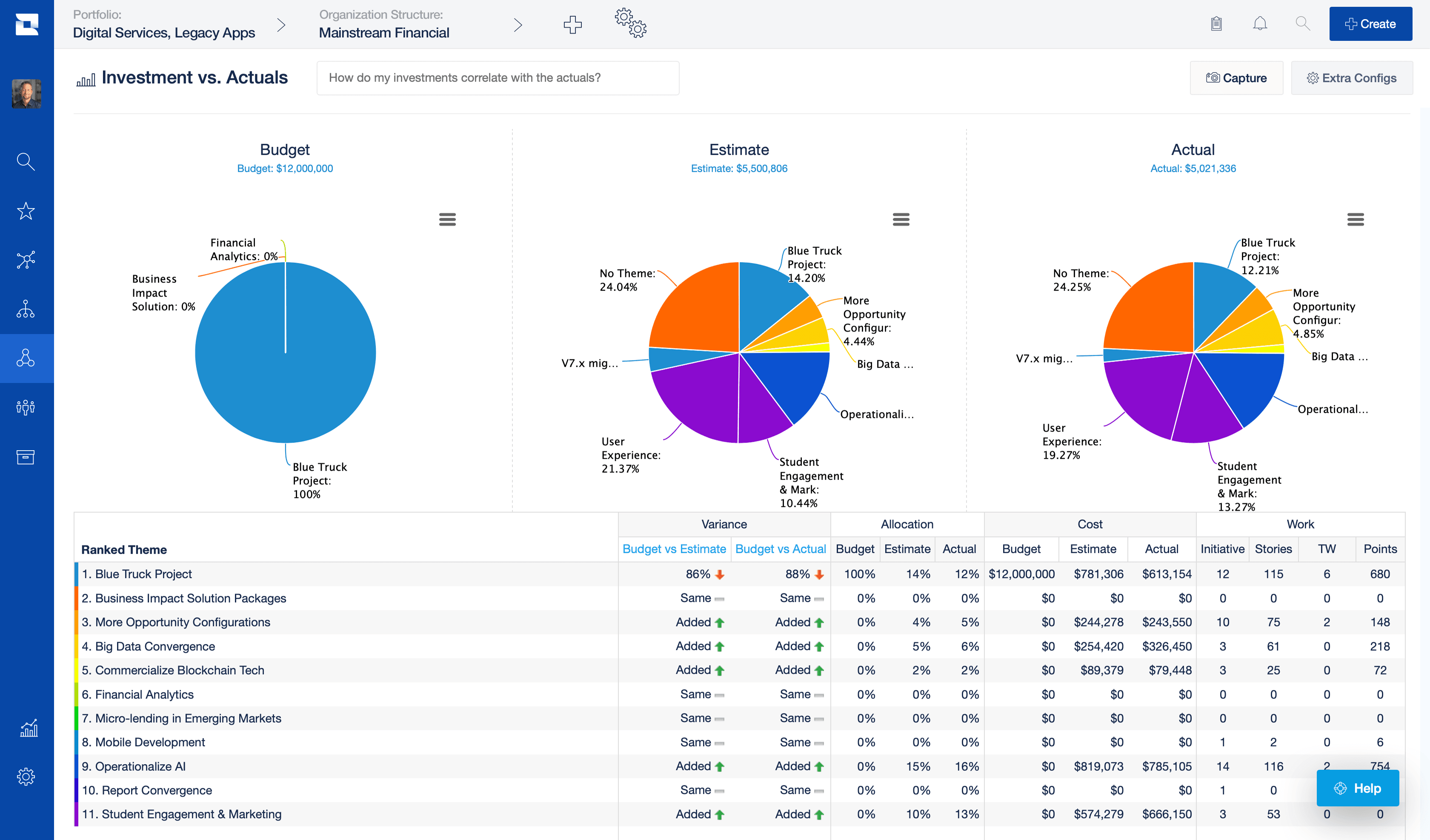In this article, you will learn about Jira portfolio management, including how to set up and use Atlassian for effective portfolio management at an enterprise scale.
Introduction to Enterprise Portfolio Management
Oxalis has decades of experience successfully implementing portfolio management processes and tools at scale. Faced with increasing global competition and a rapidly evolving technology landscape, it’s critical that organizations are capable of adapting to change and rapidly executing an appropriate strategic response. According to research done by the PMI, however, nearly 50% of all strategic initiatives fail. Strategy and tactics end up misaligned, growth stalls, and opportunities are missed. In the best-case scenario, you’ve experienced a sunk cost in the form of hundreds or thousands of person hours generating Excel spreadsheets and reports for an Annual Strategic Planning retreat that appears to have had minimal impact. At worst, you’ve been outpaced and outmaneuvered by your competition, and are beginning to lose market share.
Fortunately, we know that a scalable approach to enterprise portfolio management is in fact possible. The key to success is defining robust feedback cycles between your executive decision makers and delivery team-level contributors. A process and supporting systems must be implemented in order to enforce the reliability, accuracy, and timeliness of the data, while freeing the delivery teams to operate effectively. Atlassian’s Advanced Roadmaps and Jira Align are two tools that are commonly used to facilitate this process. In this article we cover common failure modes of enterprise portfolio management and methods to address capability gaps.

Common failure modes of Enterprise Portfolio Management
Strategy without tactics is the slowest route to victory. Tactics without strategy is the noise before the defeat. – Sun Tzu
Based on our experience working with clients across the Maritime, Government, and Healthcare industries, misalignment between business strategy and tactical execution is, unfortunately, all too common. The problem frequently stems from poor velocity and accuracy of information used for strategic prioritization and investment. Once a decision has been made, there’s little traceability between strategic priorities and tactical execution, so it becomes difficult or impossible to ensure the validity of your plans. If you’re one of the lucky organizations that have gotten past these two hurdles, it’s likely that your regimented top-down approach to maintain compliance is stifling the agility and ability of your teams to truly innovate. Let’s explore these ideas a bit further.
Decision making suffers from poor quality, low velocity data.
If you’re like most organizations, by the time you’ve reviewed a report during Annual Strategic Planning it’s too late. Those human-powered, Excel-based spreadsheets, slide decks, and infographics have been painstakingly developed by your teams over the last two or three months. This process of manually extracting and massaging the data leads to insights and decisions based on inaccurate, missing, or untimely information. You’re not confident in the veracity of the data you’re consuming, and you’re beginning to do the mental math to calculate the opportunity cost of generating the report. Even worse, you may have pointed your organization confidently in the wrong direction based on the wrong map.
There’s often limited traceability from strategic priorities to tactical execution.
Now that you’ve decided your strategic priorities, how do you ensure your teams are delivering on them? Spreadsheets, presentations, and announcements get stale, fast. Not to mention your organization has recently adopted a new Agile framework – and isn’t the point for teams to move fast and break things? Without clear traceability and visibility back to strategy, tactical execution quickly becomes unmoored. Many organizations patch over this gap by expending hundreds or thousands of PM hours developing roll-up status reports to enforce alignment.
Top-down enforcement of compliance defeats team autonomy.
Heavy-handed mandates and strict policies can do wonders to ensure team compliance. Excessive standardization and micromanagement, however, can severely limit teams’ abilities to work effectively. You find that your leadership team is no longer dictating just the “Why” behind its vision, but also “How” and “What” the teams will do to satisfy it. The result is that your teams are all pointed in the right direction, but are delivering at 50% of their capability.
Approaches to modern Enterprise Portfolio Management
We understand that Portfolio Management at scale is challenging. Now, what are some of the approaches leading organizations are taking today to address this problem? Although every organization differs based on company culture and what it’s planning for, it’s important to establish a feedback loop between your executive decision-makers and tactical delivery teams. The ultimate goal is to provide direction and clarity while enabling the teams to work and collaborate in a way that maximizes their productivity. Through our experience, we have found there are common success factors for modern Enterprise Portfolio Management.
Establish a strong planning cadence, with future plans informed by actual past results.
Your company’s success depends on the accuracy of your strategic priorities, and the quality of the data used to inform those priorities. Understand the source of your data and demand transparency into any changes which may have altered the story told. By establishing a strong feedback loop between your key objectives and what’s actually being worked by the delivery teams, you will have a much greater understanding of which projects are “winners” and deserve further investment and which projects should be stopped early to limit downside risk.

Focus on the “Why.”
Tie all tactical deliverables back to Strategic Objectives, but resist the urge to dictate “How” the teams must manage their work to get there. Strong executive sponsorship is a key ingredient to ensure that teams understand how their work relates to the bigger picture. Give your teams a target and let them chart the path that works best based on their unique experiences, skills, and preferences. Trust your organization to do things right, while verifying status with real-time data.

Leverage modern technologies and tools to accelerate collaboration at scale and unlock data driven decision making.
With the right tools and the right process, you can plan and track work across your entire portfolio with minimal overhead and effort. Modern tools such as Jira Align and Advanced Roadmaps help break down silos by providing a common data model or “language of work.” High-level strategy is tied directly to tactical execution across product, portfolio, and engineering levels. Executives are provided with real-time visibility into investment vs actuals, strategic and financial alignment, and resource allocation across the organization at large. Teams are empowered with modern, flexible tools that accelerate and fit the way they want to work, whether through Jira Software, Jira Service Management, or Jira Work Management.
While technology paves the way for efficiency gains and process improvements, it is important to consider both the People leveraging the tool and the Processes by which usage is enforced. Tools such as Jira Align are powerful and flexible but should be purposefully designed and intentionally deployed to ensure adoption is sustainable and addresses the root problems. Expert Solution Partners such as Oxalis can help by helping you chart a path from where your organization is currently at, to where you’d like to be.

How tools like Advanced Roadmaps and Jira Align can help
Both Advanced Roadmaps for Jira and Jira Align help you visualize, plan, and track work across the business. By planning and executing work in the same place, you can benefit from improved visibility, greater strategic alignment, and enhanced business agility.
Advanced Roadmaps
Advanced Roadmaps (formerly known as Portfolio for Jira) enables you to create realistic roadmaps and conduct long-term agile planning, while keeping stakeholders up to date on the work taking place at the Jira project level. We typically recommend creating a separate “Portfolio Planning” or “Initiative Planning” space in order to track the definition, prioritization, and execution of strategic initiatives. As Initiatives are given the green light to progress, delivery teams are notified and at that point the only difference in workflow is that the delivery team then “tags” their Epics or Features with the appropriate parent. This structure empowers delivery teams to work in a way that suits them best, minimizing administrative overhead while providing real-time data for cross-team roll-up reporting.

Jira Align
With Jira Align, you have the ability to connect real-time data at all levels of the organization beginning with your Mission, Vision, and Values, all the way down to individual Epics, Features, and Stories. As your executive team sets strategy and communicates down to the agile teams delivering the work, intent and strategy flow across the teams. As work is completed against Program Increments, the status, results, and outcomes are visible across the enterprise.

Some of the key features enabled by tools such as Jira Align include:
- Dependency visualization across teams, programs, and portfolios,
- Scenario planning to balance what needs to be done with how much can be done,
- and support for numerous hybrid, custom, and traditional agile frameworks such as Scrum, Kanban, SAFe, Lean Startup, Spotify, and LeSS.
Conclusion
Effective Portfolio Management at scale is critical for organizations of all sizes to compete in today’s market. Powerful tools such as Jira Align can significantly improve your chance of success by providing the right information at the right time, empowering both delivery teams and company leadership.
Tools, however, are only as effective as the people using them and the processes that define their use. Oxalis’ team of Atlassian consultants and business leaders can help, offering years of deep experience in both Enterprise Portfolio Management and Atlassian’s suite of tools. Oxalis is an expert in doing this work in an enterprise setting. To learn more about how to deploy Enterprise Jira Portfolio Management at scale, please contact us to learn more. Do you need help with Jira Portfolio setup or Portfolio Management for Jira? Feel free to send us a message.








